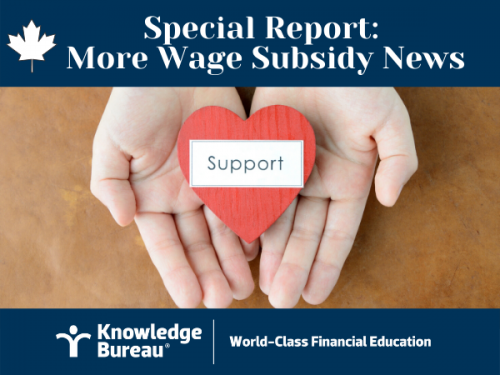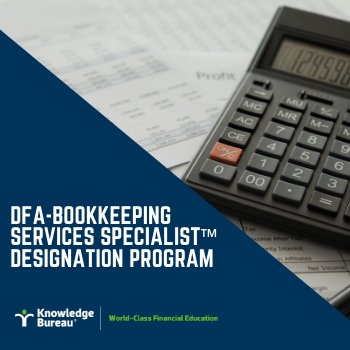Last updated: April 13 2020
Wage Subsidy: Finally, Details on New EI/CPP Refunds

Evelyn Jacks
With the passing of Bill C-14, the COVID-19 Emergency Response Act, No. 2 on April 12, 2020 Canadian businesses have some surety on the 75% Canada Emergency Wage Subsidy (CEWS), and the money could flow in 2 to 5 weeks. However, there are some of the important new details to consider including a new refund of the employer’s portion of EI/CPP benefits.
Applying for the CEWS. At this time, the application process has not yet been fully fleshed out. What’s currently clear about the application process is that employers would submit their applications through CRA’s My Business Account portal. Specific details about an alternate web portal have not been announced. In addition, the My Business Account portal was closed from 11 pm on Sunday April 12, 2020 to 6 am Monday April 13, 2020 to allow for systems maintenance for the Canada Emergency Response Benefit (CERB). We’ll keep you up to date as we know more about the application process for the CEWs.
When applying for the CEWs, employers must show that the decline in revenues is enough to qualify in each claim period, and report on the remuneration paid to employees. Owners who pay themselves a salary or wage must also report their remuneration amounts. At least 75% of the pre-crisis salary must be paid to each employee, and the full amount of the benefit received must be passed along to the employee. Employers are expected to use “best efforts” to top up salaries to pre-crisis levels.
How long can an employer collect the benefit? The 75% wage subsidy is available to eligible employers for up to 12 weeks, retroactive to March 15, 2020. There is no overall limit to the amount of subsidy the employer can claim in the period, but there are maximum amounts claimable per employee.
What is the maximum that can be collected per employee? The maximum benefit is the lesser of $847 a week and 75% of the employee’s pre-crisis weekly remuneration. There is no  upper limit to the number of employees who may be eligible, if the eligibility criteria is met:
upper limit to the number of employees who may be eligible, if the eligibility criteria is met:
- Existing employees. The wage subsidy is based on the average weekly pre-crisis remuneration paid to an employee between January 1, 2020 and March 15, 2020 inclusively. It excludes any seven-day periods for which the employee received no remuneration.
- New employees. Employers can also apply for 75% of salaries and wages paid to new employees. Not included in the calculation is severance pay, stock option benefits or the personal use of a corporate vehicle.
- Related employees. Wages paid to non-arm’s length employees, including family members can qualify, but is limited to amounts paid in any period between March 15 and June 6 if the employee was employed prior to March 15, 2020.
- Rehired employees. Rehired employees in receipt of the $2,000 a month Canada Emergency Response Benefit (CERB) will need to repay those benefits if they cross over with the Wage Subsidy in the rehiring period. Both employer and employee should keep excellent records.
Who are eligible employers? Eligible employers are individuals, taxable corporations, partnerships consisting of eligible employers, non‑profit organizations and registered charities; public bodies including municipalities, schools and hospitals do not qualify.
Employers must attest to a drop in revenues of at least 15%in March 2020 and 30% in the months that follow.
Employers can use a year-over-year monthly comparison (example March this year to March last year) or a comparison of current month revenues to the average revenue earned in January and February 2020. Whichever approach is used initially, must then be used throughout the claim period.
Revenues must be earned from arm’s length sources, calculated based on either a cash received or accrued income basis, but not a mix of both. These revenues would exclude extraordinary items and amounts received on account of capital. There are certain exclusions for related and affiliated companies and groups.
Note: Once an employer is found eligible for a specific period, the employer would automatically qualify for the next period.
Here are the eligible claiming periods; note the CEWS received in a period is ignored for these purposes.
|
Period |
Date |
Revenue Reduction |
Reference Period for Eligibility |
|
1 |
March 15 to April 11 |
15% |
March 2020 over March 2019 or Average of January and February 2020 |
|
2 |
April 12 to May 9 |
30% |
Eligible for Period 1 OR April 2020 over April 2019 OR Average of January and February 2020 |
|
3 |
May 10 to June 6 |
30% |
Eligible for Period 2 OR May 2020 over May 2019 OR Average of January and February 2020 |
Refund of Employer’s Portion - EI, CPP, QPP and Quebec Parental Insurance Plan Premiums
Employers must continue to deduct and remit these premiums for employees who are on paid leave and for whom the CEWS is being collected for. However, when applying for the CEWS, employers will also be able to apply for a new refund of 100% of the employer-paid contributions to these plans.
- Who is considered to be on paid leave? This is an employee who is paid for the whole week but is not able to perform any work because the business is unable to open due
 to COVID-19.
to COVID-19.
- Who is not? People who are on leave with pay for only a part of a week – no refund of premiums is available in this case.
Audit-proofing. With the number of intersection provisions announced by the government in the last month, employers will need to carefully track their revenues as per the above, especially if other programs are being taken advantage of. For example:
- The 10% temporary wage subsidy. Employers eligible for both the CEWS and the 10% wage subsidy for a period must reduce the amount claimed for the subsidy by the 10% payroll reduction taken.
- The 76-week EI Work Sharing Program. EI benefits received by employees will reduce the benefit the employer can receive through the CEWS.
CRA warns that the CEWS will need to be repaid if the eligibility requirements outlined above are not met, and there will be stiff penalties and the potential of jail in the case of fraud. Anti-abuse rules will ensure that employers who engage in artificial transactions to reduce revenues to get the CEWS will pay a penalty of 25% of the wage subsidy received plus repay the amount itself.
Small business clients will want to consult with their DFA-Tax Services Specialist™ and DFA-Bookkeeping Services Specialist™ for assistance in making the proper application, payroll withholdings and remittances and provide the audit-proof financial documentation for this year over last year, or comparisons to the average of January/February revenues.
Additional educational resources: For detailed information and explanations on these provisions, sign up this week for the Virtual CE Summit. The theme is SOUND ADVICE FOR TOUGH TIMES: Planning for Income & Business Recovery. Save $300 by registering by April 17; then receive the comprehensive online Knowledge Journal and CE course on April 22. Your tuition fees also include participation with expert instructors in the Virtual CE Summit meeting on May 13.
COPYRIGHT OWNED BY KNOWLEDGE BUREAU INC., 2020.
UNAUTHORIZED REPRODUCTION, IN WHOLE OR IN PART, IS PROHIBITED.
